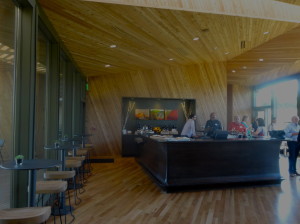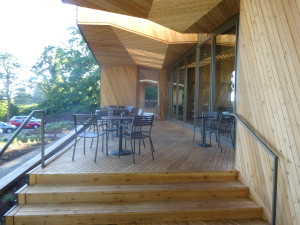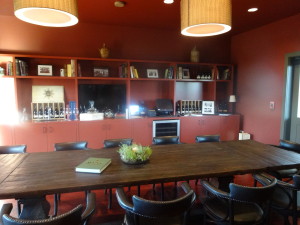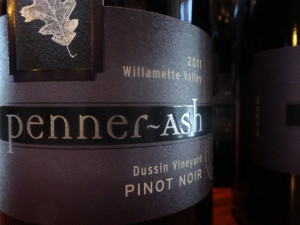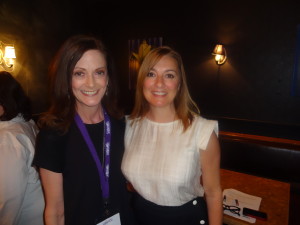Wine country tourism is on the rise and one of the fastest growing destinations is Oregon’s Willamette Valley. I’ve visited the past two summers (July and August are relatively dry with pleasant if not hot weather) and after my last visit came away convinced that the Willamette Valley is a destination that should be on every wine lover’s list. Why? It’s not just the amazing Pinot Noir, the grape varietal the region is most famous for. There’s more and more to see, eat and drink than ever before, and it’s only going to get better. Wine giant Jackson Family Wines (aka Kendall Jackson) jsut bought a winery in the Willamette Valley, as did French wine house Louis Jadot, its first US acquisition. Here, my favorite experiences.
Sokol Blosser’s new tasting room
Talk about a destination winery, this is a building for art and architecture as well as wine fans alike. Sokol Blosser is a family owned winery whose roots go down deep in the Dundee Hills AVA, where they’ve been making wine since 1977. Their first tasting room was built in 1978, but with visits to the winery booming, they quickly outgrew the space.
“Oregon has been getting amazing international recognition for the quality of our wines and the next frontier I think for Oregon is in tourism and hospitality,” says Alison Sokol Blosser, second generation and winery co-president. She and her family didn’t want to just recreate a tasting room where you go up to the bar and try wine. They wanted to be able to offer different tasting experiences and the ability to customize visits, one that would help drive tourism to the Willamette Valley.
Sokol Blosser hired renown architect Brad Cloepfil of Portland-based Allied Works Architecture to create their vision of a modern yet functional tasting room. “He is an artist,” says Alison. “As you walk and look at all the angles and the details he didn’t just build a building, he built a piece of art.” The tasting room is nestled into the rolling vineyards and the design takes every advantage of showing off those views. Driving up to the building, you can actually see through it to the vineyards in the back. It looks like a wood block that has been carved into many pieces, yet it is all uniform thanks to the cedar siding used throughout.
You’ll find a tasting bar, but then there’s the front porch, where you can sit and enjoy table service of wine flights, a relatively new experience in the Willamette Valley. You can do a wine and cheese tasting at a table in the kitchen, or do a vertical tasting of Pinot Noir in the wine library, a vibrant red space that’s a little unexpected but has the vibe of an actual library.
While keeping the visitor experience in mind was paramount, so was keeping true to Sokol Blosser’s values of being sustainable throughout the entire operation. They were the first winery in the country to be LEED certified for their underground barrel cellar in 2002 and all the vineyards are certified organic. With the new tasting room, they decided to go for a certification called the Living Building Challenge. Requirements are based on “petals” and there are seven petals, including water, energy, site and beauty. It takes a year after a building is complete to earn certification because you have to prove things like net zero energy. Should the Sokol Blosser tasting room be certified, it will be the first winery in the US to attain the Living Building Challenge.
There’s a definite wow factor to the Sokol Blosser tasting room, from the artistry of the design, to how well it defines the Willamette Valley experience, something very natural and organic, with a distinct sense or place, or terroir as we say in wine.
Chef Sunny Jin at JORY Restaurant at The Allison Inn & Spa
His credentials are most impressive. After attending culinary school in Portland at the Western Culinary Institute Sunny Jin first landed at The French Laundry, under the tutelage of chef Thomas Keller. Then he went to Tetsuya’s in Sydney, Australia, working with renown chef Tetsuya Wakuda. From there he spent a year in the kitchen at the now closed El Bulli in Spain, the world famous center of molecular gastronomy as practiced by chef Ferran Adria.
Chef Jin says after that experience, he was ready to find home, and where would that be? He loved the time he spent in Oregon during culinary school, so that’s where he headed, even though he didn’t have a job lined up. “My car was packed I was already on the road,” he says. “JORY was the only place the first place I contacted and said I don’t really have a plan but I’m coming to Oregon.”
Fortunately for our palates, JORY, the restaurant at the Allison Inn & Spa offered him a job in the kitchen. He quickly rose to the ranks of Executive Chef. While JORY’s menu had already been based on sourcing local ingredients, Chef Jin kicked that philosophy up a few notches, exploring the area, knocking on doors to find new sources for eggs, peaches and mushrooms. “We do all our house curing, the ham, the bacon, all from local heritage hogs. Blackberries, blueberries, raspberries all less than five miles away.”
He’s like a kid in a candy store, having all that access to the best locally raised products. Chef Jin loves having farmers bring him whatever is fresh that day, which challenges him to create a dish honoring that ingredient. Take peaches. “There’s a gentleman by the name of Lloyd who owns a peach farm seven miles away,” says Chef Jin. “He brought these peaches yesterday and they’re beautiful the first peaches of the season. I’m thinking ok I’ve got to do as little as possible to these peaches because they are just perfect.” He was dreaming up a dish with sprouted wheatberries, grilled peaches and duck or grilled port. Mmmmm.
Chef Jin has his own kitchen garden to pull from as well. A chilled cucumber soup with a Dungeness crab garnish was made from English cucumbers that they grow. Yellow ume plum shows up in an amuse bouche with blue cheese and bacon. Peaches make an appearance on a dish with burrata and pork belly, a nice contrast of sweet, salty and creaminess. Local albacore, which runs just two weeks a year, is a highlight on the menu.
JORY Restaurant takes its name from a type of soil that surrounds the restaurant and The Allison Inn. It’s good for veggies, but it’s also good for grapes, and there’s eight acres of a Pinot Noir vineyard on the grounds, which will be going into the house label wine for the first time, in the 2012 Austin Knoll Pinot Noir. Dining here is an all around locavore, farm to table experience that will keep you wanting to come back for more of Chef Jin’s creative and utterly delicious menu.
Penner-Ash Wine Cellars

Many people consider Lynn Penner-Ash to be Oregon’s first lady of wine. She arrived in the Willamette Valley in 1988 at Rex Hill Winery, after stints working at Domaine Chandon and Stag’s Leap Wine Cellars in Napa Valley. There were no female led wineries when she arrived in Oregon, and she eventually struck out on her own. She is a spitfire, full of energy but also has exacting standards when it comes to making wine. Lynn makes some of the most acclaimed Pinot Noirs around, and she does that by both growing and sourcing the grapes.
While the property that the Penner-Ash winery sits on, in the Yamhill-Carlton AVA, was planted in 2003, it wasn’t until this past June that Lynn and her husband Ron were able to purchase the vineyard property outright. There are 15 acres planted to vine on the 80 acre property that boasts views, on a clear day, of snow-capped Mt. Hood. They farm for low yields and high quality here, and also at the vineyards where they’ve had long term contracts for 25 years.
Lynn designed the winery to handle small lots – two ton fermenters, all gravity flow, and she even put all the noisy equipment underground, so that the winery is one of the quietest I’ve ever been in. Not to say that things don’t get rocking, especially during harvest. This summer the Penner-Ash winery has been hosting concerts, including one by Lisa Marie Presley. Lynn and Ron love their music.
Lynn also custom crushes for other labels here, and has designed the winery with separate barrel rooms for each label. That allows her to customize temperature and other factors according to the type and style of wine she is making. She’s got it all thought out, even adding “Juliet” balconies at different levels in the winery to allow visitors to view harvest operations while not getting in the way.
All this attention to detail comes out in the glass. The Penner-Ash Pinot Noirs are receive rave reviews and rightly so. While there I tasted a 2000 Estate Pinot Noir which was just amazing, still full of life and fruit, but with that wonderful earthiness that Pinot develops as it ages. What you may not know is Penner-Ash is also producing one of the best American Viogniers. It’s a happy accident, as Lynn did not set out to produce a single varietal Viognier. She was co-fermenting Viognier with her Syrah, as is the style in the northern Rhone appellation of Cote-Rotie. But one year the Viognier fruit looked too good. So she said to Ron, why don’t we make it as a single varietal? That was 15 cases in 1999. “We sold out in a day,” says Lynn. Now she’s making 1000 cases. “I am now one of the largest producers of Viognier in the state of Oregon.” I am a fan of her unoaked, non-malolactic fermentation crisp, bright peachy Viognier. Please keep making it.



